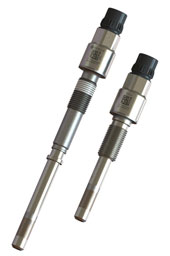A new version of Sensata’s award-winning Cylinder Pressure Sensor (CPS) is attracting attention as a critical component to lowering exhaust emissions and increasing fuel efficiency in next-generation engine combustion systems.
 Development partners Sensata and Beru released their first generation CPS in series production in 2007 which made it possible to directly measure the combustion process in a diesel engine by incorporating a sensor into the glow plug (as in Opel engines). The device enabled diesel automakers to eliminate up to 90 percent of harmful pollutants and boost fuel economy, helping to meet Europe’s strict emission standards.
Development partners Sensata and Beru released their first generation CPS in series production in 2007 which made it possible to directly measure the combustion process in a diesel engine by incorporating a sensor into the glow plug (as in Opel engines). The device enabled diesel automakers to eliminate up to 90 percent of harmful pollutants and boost fuel economy, helping to meet Europe’s strict emission standards.
The newer, miniaturized CPS, called Cylinder Pressure Only Sensor (CPOS), can be installed separately from the existing glow plug, enabling OEMs to opt for more durable ceramic diesel glow plugs. It also enables use in gasoline engines.
Tim Tiek , marketing manager of Sensata’s global Combustion Sensors business, said, “Our new design builds on existing CPS technology that has proven to be durable as well as extremely accurate and stable with several million CPS already in the field. Sensata’s CPOS sensor builds on this experience, allowing customers to utilize next-generation, closed-loop combustion systems. Sensata’s application knowledge and close customer cooperation enabled us to optimize the CPOS design to maximize emission reduction, deliver the best possible fuel economy and help our customers save on overall system cost.”
Daimler is the first company in the world to launch high volume production with the innovative CPOS for the majority of their diesel engines. In a presentation at the 10th International Symposium on Combustion Diagnostics in May 2012, Ruediger Pfaff, Manager of Diesel Combustion Technology Development for Daimler, described the benefits of combustion pressure sensors in a presentation on development work Daimler is doing to lower emissions and fuel consumption of diesel engines by using closed-loop combustion control.
Mr. Pfaff stated, that, after extensive testing, which started with the installation space and manufacturing investigations of the cylinder head and culminated in numerous sensor and endurance tests, Daimler favored Sensata’s stand-alone solution. Estimates are that use of combustion pressure sensors can reduce fuel consumption by 2 percent, reduce nitrogen oxide raw emissions by up to 30 percent and compensate for fuel quality differences.
The ability to incorporate future pressure sensor and glow plug innovations in a standardized manner independently of each other in the different engine type numbers or country variants was also seen as a major advantage.
Sensata Engineering Manager Marc Borgers said, “During the early development work with Daimler, we focused on delivering a robust solution able to withstand high temperatures and heavy soot conditions. The capabilities of CPOS have been proven by extensive validation tests and many field tests. Its accuracy (< +2%) over its lifetime bodes well for future functions such as power boosting and improved engine diagnostics and could help alleviate the cost of complex and expensive exhaust after-treatment solutions.”
Sensata CPOS technical data
| Configuration | |
| Mounting Dimension | HEX12 |
| Thread of the Pressure Port | M10x1 (M8 available) |
| Electrical Connector | Coaxial connection system |
| Functional Characteristics | |
| Operating Temperature | -40°C to 140°C |
| Operating Pressure | Customer specific: 0 to 150 / 250 Bar |
| Proof Pressure | Customer specific (250 bar) |
| Burst Pressure | Customer specific (300 bar) |
| Lifetime Expectancy | 250.000 km and beyond12.000 hours |
| Stable Output | ± 2% over lifetime |
| Gain Accuracy | ± 2% of Vs over life |
| Non Linearity | < ± 1% of Vs over life |
| Hysteresis | < ± 1% of Vs over life |
| Offset Variation | ± 1% of Vs over life |
| Accuracy | 0–5 bar low pressure:±0.4% of Vs (10°C to 140°C)±0.6% of Vs (-40°C to 10°C) |
| Supply Voltage | 5.0 ± 5% VDC (customer specific) |
| Supply Current | Max 1 0mA |
| Load Resistor | 4.7 kOhm Pull up |
| Response Time For Signal Delay | <200 us total |
| Nominal Output Voltage | 11.5% Vs to 91.5% Vs |
| Output Noise RMS | <0.2% of Vs |
| Overvoltage Protection | 24 V |
| Reverse Voltage Protection | -13.5 V |
| Signal Resolution | <50 mBar (analog) |
| Bandwidth | 15 kHz |
Source: Sensata
Romain’s opinion:
Such a sensor is really difficult to package in the cylinder head. It implies a redesign of it and hence an important investment in terms of tooling costs. A lot of manufacturers are not ready to pay for such a manufacturing investment. Hence, this kind of innovation should be considered when it is planned to change the cylinder head tooling, for a new engine platform for example, and at the really beginning of the project. I guess that explains why so few OEM have installed a cylinder pressure sensor on their engines. Do you think this kind of sensor will equip all of the engines in the future? And if yes, when?





















Hi Romain, actually the it is worth to invest to this technology. More OEM right now looking for the opportunity to equipped this sensor to their engine.